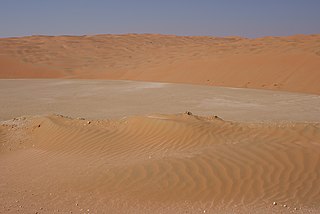Rub al-Khali
| Rub al-Khali | |
|---|---|
|
Location of the Rub al-Chali on the Arabian Peninsula |
|
|
Sand dunes in the Rub al-Chali |
|
| location |
|
| part of | Arabian Peninsula |
| Coordinates | 20 ° 0 ′ N , 50 ° 0 ′ E |
| surface | 680,000 km² |
| particularities | Largest sand desert on earth |
|
Rub al-Kali from space |
|
The Rub al-Chali ( Arabic الربع الخالي ar-Rubʿ al-Chali , DMG ar-Rubʿ al-Ḫālī 'Empty Quarter', English transcription also Rub al-Khali ) is the largest sandy desert on earth. The almost deserted desert covers the southern third of the Arabian Peninsula . Similar to the Sahara , it is a tropic desert due tothe trade winds .
geography
It stretches with an area of 680,000 square kilometers from Najd in the north, where the Nefud desert adjoins, to Hadramaut in Yemen in the south and to the United Arab Emirates in the northeast. In the south, the Rub al-Chali is climatically limited by areas that are under the influence of the monsoons , like the Dhofar region ( Oman ) .
The desert consists largely of sand dunes that can be up to 300 meters high. They extend over an area of over 500,000 km². Many of the dry rivers ( wadis ) emerging on the Arabian Peninsula seep into the dry Rub al-Chali.
In the north of the desert is the large Liwa oasis , from where a cul-de-sac leads to the Moreeb dune , which is considered the highest in the Rub al-Chali. Due to its very steep incline of around 50 degrees, it is preferred for desert-specific motor sports.
To the east lie Wabar Crater, three by meteorites caused impact craters with diameters ranging from eleven to 116 meters.
exploration
The British Bertram Thomas made the first expedition through the Rub al-Chali in 1930–1931 on a relatively easy route. In 1932 his compatriot St. John Philby followed him and crossed the western part of the desert on his 3000 kilometer tour. The eccentric British explorer Wilfred Thesiger was only able to cross it completely in 1946 .
From February 25th to March 9th, 2006 the state organization “Saudi Geological Survey” (SGS) carried out an extensive research trip in the desert.
Climate and vegetation
The amount of precipitation is 40 to 100 mm per year, which is why the desert is classified as hyperarid . The temperatures of the tropic desert can fluctuate from freezing point at night to 60 ° C during the day. Despite a considerable cooling, the values hardly fall below 25 ° C at night. The humidity is low all year round and is often only 20% in summer. Despite the harsh conditions, the sandy desert represents its own ecosystem . Spiders , rodents and some, if few, plant species can be found throughout the desert .
People
The Rub al-Kali is largely unexplored, apart from remote sensing from space using satellites. To this day it is one of the most inaccessible areas on earth. The Bedouins also avoid the desert and only use camels to graze on the edges of the desert .
To 300 AD, attracted incense - caravans through the desert. The desertification took over the last millennia, made this trade missions impossible and left the once wealthy trading city of Ubar in the sand sink.
literature
- Wilfred Thesiger: Arabian Sands. 1959
- The wells of the desert. With the Bedouins through the unknown Arabia. Malik, Munich 2002, ISBN 3-89029-225-9 .
- Bruce Kirkby: Sand Dance: By Camel Across Arabia's Great Southern Desert. McClelland and Stewart, 2000.
- In the empty quarter. On the camel through the Arabian desert. With a foreword by Wilfred Thesiger. Malik, Munich 2001, ISBN 3-89029-209-7 ; Piper, Munich / Zurich 2003, ISBN 3-492-23865-3 .
Rub al-Kali in fiction
In the last chapter of the novel The Book of Eden by Kai Meyer , the protagonists pave their way in 1258 in a remote part of the Rub al-Chali in search of the “garden of God”.
In her novel The Promise of the Desert, Katherine Webb describes the first crossing of the “empty quarter” by an adventurous Englishwoman at the beginning of the 20th century.
Movie
- Atlantis of the desert. The secret of the Rub al-Khali oasis. Reportage, Germany, 2011, 42:30 min., Script and director: Marc Eberle, production: CineCentrum, ZDF , series: Humboldts Erben, first broadcast: March 9, 2003 on 3sat , summary by 3sat.
literature
- Tim Healey, Andreas Held (translator): Discoverer and adventurer. Row: Our 20th Century. Verlag Reader's Digest - Das Beste, Stuttgart 1999, ISBN 3-87070-830-1 (About Bertram Thomas; with numerous illustrations - from English).
Web links
- Helge Sobik: Rub al-Khali desert: The sandman. In: Spiegel Online , April 30, 2012
Individual evidence
- ↑ a b c Matter, Albert, et al .: Palaeo-environmental implications derived from lake and sabkha deposits of the southern Rub'al-Khali, Saudi Arabia and Oman. In: Quaternary International. 382, 2015, pp. 120-131. ( researchgate.net PDF 6.06MB)
- ↑ Abu Dhabi Motors Club: LIWA 2012 Final Coronation ( Memento of the original dated December 2, 2007 in the Internet Archive ) Info: The archive link was inserted automatically and has not yet been checked. Please check the original and archive link according to the instructions and then remove this notice.
- ↑ Michael Martin : The deserts of the earth. Frederking & Thaler, Munich 2004, ISBN 3-89405-435-2 , p. 353.
- ^ The Empty Quarter in: Saudi Geological Survey, October 21, 2010.



